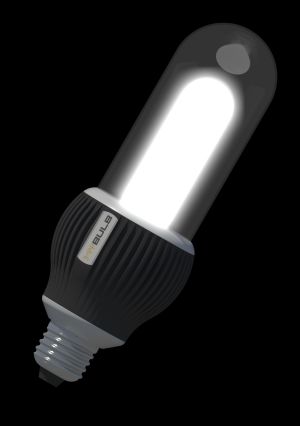Absence of mercury, a favorable CO2 balance, low costs of manufacture, and an excellent light quality are the features characterizing the electrode-free low-energy bulb “3rdPPBulb” that was co-developed by scientists of the Light Technology Institute (LTI) of Karlsruhe Institute of Technology (KIT). KIT scientists contributed the mercury-free filling, fluorescent coating, inner coating as well as the geometry of the innovative bulb. At a press conference on Monday, April 16, 12.30 hrs at the “light + building“ fair in Frankfurt, the consortium from Aachen and Karlsruhe will present the “3rdPPBulb“.
The research consortium headed by Professor Dr. Holger Heuermann from the Aachen University of Applied Sciences and Dr. Rainer Kling from LTI of KIT is working on electrode-free low-energy bulbs as a convincing alternative to conventional mercury-containing compact fluorescent tubes. In Germany, several millions of these compact fluorescent lamps (CFL) are sold annually. They are to save energy and the environment. Due to their mercury content, however, they have about the opposite effect. Suppliers of CFL have to guarantee proper disposal by local organizations. Transportation from households to collection points, processing, and recycling plants alone requires an enormous logistic expenditure. This adversely affects the CO2 balance of CFL.
For the new “3rdPPBulb”, scientists of the Light and Plasma Technologies Division of LTI have tested a number of materials until they found a good combination of metal-containing compounds to replace the mercury. “Replacement will take place step by step,” explains Celal Mohan Ögün, scientist at LTI. “The bulb already is nearly free of mercury.” At a power consumption of 19 Watts, less than 10 µg of mercury per bulb are required to generate a luminous flux of about 840 Lumen. This corresponds to an effective light yield of about 54 Lumen/Watt and, hence, to a 75 Watt bulb. The amount of mercury still required only amounts to 0.002 times the permissible amount. By late 2012/early 2013, the “3rdPPBulb” is planned to be completely free of mercury. The LTI scientists also developed a special inner fluorescent coating that converts ultraviolet radiation into visible light and an inner coating preventing the filler from diffusing into the bulb. In addition, they conceived a new geometry to ensure homogeneous temperature distribution and power supply.
The researchers from Aachen were responsible for the development of the ballast. The trigger electrode of the “3rdPPBulb” is located outside of the bulb. During manufacture, no conventional electrodes are needed, which considerably reduces the costs. As no electrodes are located in the gas discharge chamber, electrode burn-off is excluded. Electrode-free bulbs are characterized by a usually longer service life. With an average use of 3 hours daily, the bulb may presumably be used more than 27 years.
The bulb is designed such that the materials can be recycled easily. As a result, its lifecycle from manufacture to operation to recycling is characterized by a more favorable CO2 balance. The new bulb also has clear advantages for the consumer: Very high luminous density, good color reproduction, pleasant light colors, dimmability, and a shorter starting phase.
Aachen University of Applied Sciences and KIT will present the “3rd PPBulb“ at a
press conference on Monday, April 16, 12.30 hrs,
at “light and building 2012“, Messe Frankfurt,
Ludwig-Erhard-Anlage 1, 60327 Frankfurt/Main,
hall 3.C, room “Argument“.
Representatives of the media are cordially invited to come to the press conference. Kindly register at press ∂does-not-exist.3ppbulb com until April 15 at the latest. For accreditation, please bring along your press card. After the press conference, individual interviews can be made.
In close partnership with society, KIT develops solutions for urgent challenges – from climate change, energy transition and sustainable use of natural resources to artificial intelligence, sovereignty and an aging population. As The University in the Helmholtz Association, KIT unites scientific excellence from insight to application-driven research under one roof – and is thus in a unique position to drive this transformation. As a University of Excellence, KIT offers its more than 10,000 employees and 22,800 students outstanding opportunities to shape a sustainable and resilient future. KIT – Science for Impact.

